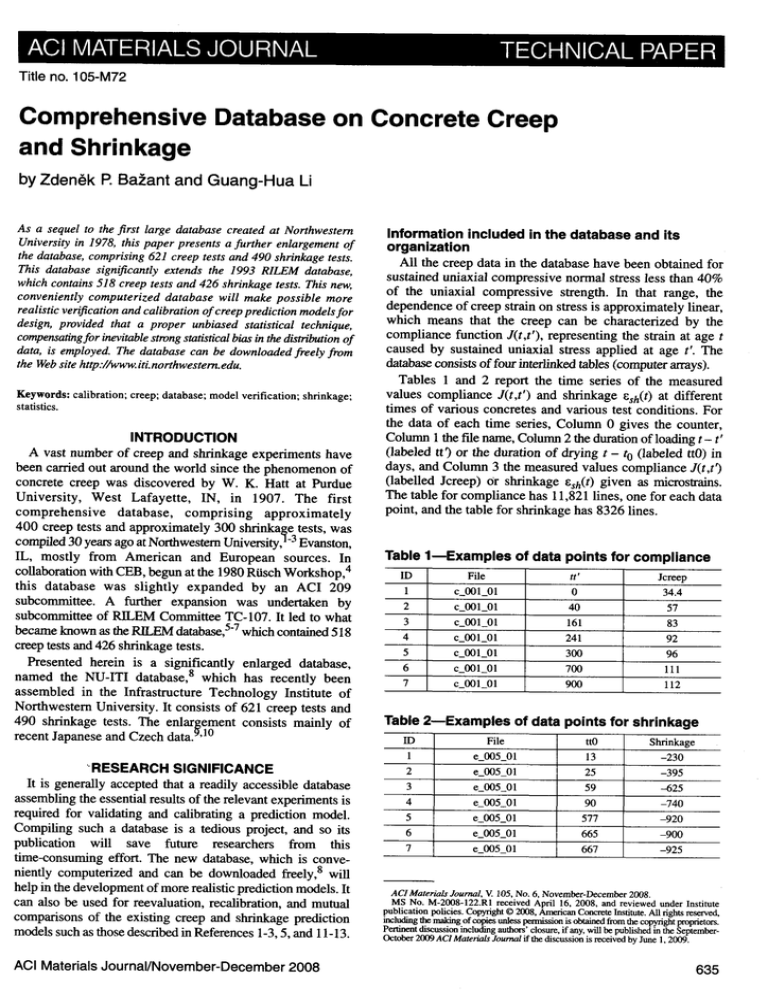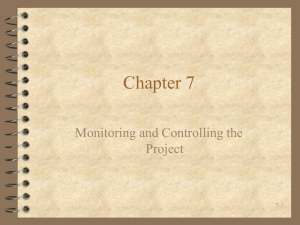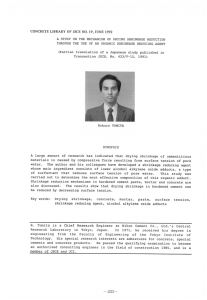
ACI MATERIALS JOURNAL
TECHNICAL PAPER
Title no. 105-M72
Comprehensive Database on Concrete Creep
and Shrinkage
by Zdenek P. Bazant and Guang-Hua Li
As a sequel to the first large database created at Northwestern
University in 1978, this paper presents a further enlargement of
the database, comprising 621 creep tests and 490 shrinkage tests.
This database significantly extends the 1993 RILEM database,
which contains 518 creep tests and 426 shrinkage tests. This new,
conveniently computerized database will make possible more
realistic verification and calibration of creep prediction models for
design, provided that a proper unbiased statistical technique,
compensating for inevitable strong statistical bias in the distribution of
data, is employed. The database can be downloaded freely from
the Web site http://www.iti.northwestern.edu.
Keywords: calibration; creep; database; model verification; shrinkage;
statistics.
INTRODUCTION
A vast number of creep and shrinkage experiments have
been carried out around the world since the phenomenon of
concrete creep was discovered by W. K. Hatt at Purdue
University, West Lafayette, IN, in 1907. The first
comprehensive database, comprising approximately
400 creep tests and approximately 300 shrinka~e tests, was
compiled 30 years ago at Northwestern University, -3 Evanston,
IL, mostly from American and European sources. In
collaboration with CEB, begun at the 1980 Rusch Workshop,4
this database was slightly expanded by an ACI 209
subcommittee. A further expansion was undertaken by
subcommittee of RILEM Committee TC-l 07. It led to what
became known as the RILEM database,5-7 which contained 518
creep tests and 426 shrinkage tests.
Presented herein is a significantly enlarged database,
named the NU-ITI database,8 which has recently been
assembled in the Infrastructure Technology Institute of
Northwestern University. It consists of 621 creep tests and
490 shrinkage tests. The enlar§.ement consists mainly of
recent Japanese and Czech data. ,10
Information included in the database and its
organization
All the creep data in the database have been obtained for
sustained uniaxial compressive normal stress less than 40%
of the uniaxial compressive strength. In that range, the
dependence of creep strain on stress is approximately linear,
which means that the creep can be characterized by the
compliance function J(t,t'), representing the strain at age t
caused by sustained uniaxial stress applied at age t'. The
database consists of four interlinked tables (computer arrays).
Tables 1 and 2 report the time series of the measured
values compliance J(t,t') and shrinkage f.sh(t) at different
times of various concretes and various test conditions. For
the data of each time series, Column 0 gives the counter,
Column 1 the me name, Column 2 the duration ofloading t- t'
(labeled tt') or the duration of drying t - to (labeled ttO) in
days, and Column 3 the measured values compliance J(t ,t')
(labelled Jcreep) or shrinkage f.sh(t) given as microstrains.
The table for compliance has 11,821 lines, one for each data
point, and the table for shrinkage has 8326 lines.
Table 1-Examples of data pOints for compliance
ID
I
2
3
4
5
6
7
"RESEARCH SIGNIFICANCE
ACI Materials Journal/November-December 2008
Jcreep
34.4
57
83
92
96
111
112
tt'
°
40
161
241
300
700
900
Table 2-Examples of data pOints for shrinkage
ID
I
It is generally accepted that a readily accessible database
assembling the essential results of the relevant experiments is
required for validating and calibrating a prediction model.
Compiling such a database is a tedious project, and so its
publication will save future researchers from this
time-consuming effort. The new database, which is conveniently computerized and can be downloaded freely,8 will
help in the development of more realistic prediction models. It
can also be used for reevaluation, recalibration, and mutual
comparisons of the existing creep and shrinkage prediction
models such as those described in References 1-3,5, and 11-13.
File
c 001_01
c_ool_Ol
c 001 01
c_ool_OI
c ooLOI
c_ool_OI
c 001_01
2
3
4
5
6
7
File
e 005 01
e_005_01
e_005_01
e_005_01
e_OO5_01
e_OO5_01
e_OO5_01
!to
13
25
59
90
577
665
667
Shrinkage
-230
-395
-625
-740
-920
-900
-925
ACI Materials Journal, V. 105, No.6, November-December 2008.
MS No. M-2008-122.RI received April 16, 2008, and reviewed under Institute
publication policies. Copyright © 2008, American Concrete Institute. All rights reserved,
including the making of copies unless pennission is obtained from the copyright proprietors.
Pertinent discussion including authors' closure, if any, will be published in the SeptemberOctober 2009 ACI Materials Journal if the discussion is received by June I, 2009.
635
13. Modulus of elasticity E (E28) at 28 days of age, in MPa
(which generally does not correspond to initial deformation
in creep test ll ).
14. Size and shape (Geometry) of specimens: P is a square
prism, length times height, in mm; C is a solid cylinder,
diameter times height, in mm; HC is a hollow cylinder,
diameterlldiameter2 times height, in mm; S is a slab, length
times length times height, in mm; and CU is a cube, side
inmm.
15. Effective thickness D of specimen (2VS), that is, 2 x
(specimen volume)/(surface exposed to environment), in mm.
16. Environmental humidity (HO) of specimen preconditioning, in percent (if unsealed).
17. Age t' at loading, or age to (or to) at the beginning of
environmental exposure, in days.
18. Temperature (T), in °C.
19. Type of heating (Heat), if any.
20. Environmental relative humidity (H) in percent during
the test (99 means a sealed specimen, 100 means storage in
water).
21. Stress level = stress/(compressive strength) at the
beginning of loading (Sigfc).
22. Sustained stress during the test, 0", in MPa (Sigma).
23. Location or geographical region of test.
24. Year of test or year of publication.
25. File name.
Tables 1 to 4 show examples of several lines of each table.
It must be admitted that many of the tests in the database
did not use the test procedure that is today considered
optimal. 14 Nevertheless, the results of these tests are valuable
and there is no better substitute for them. Also, many tests in
the present database were conducted on old types of concrete
not in use today. These tests, however, still give useful
information on the relative increase of creep and shrinkage
over long times, and their percentage in the present database
is lower than in the previous databases.
Zdenek P. BaZant, FACI, is the McCormick Institute Professor and w.P. Murphy
Professor of Civil Engineering and Materials Science at Northwestern University,
Evanston, IL. He is a Registered Structural Engineer in Illinois. He has received six
honorary doctorates. He is a Past Chair and member ofACI Committee 446, Mechanics of
Concrete, and a member ofACI Committees 209, Creep and Shrinkage in Concrete; 348,
Structural Safety; and Joint ACI-ASCE Committees 334, Concrete Shell Design and
Construction; 445, Shear and Torsion; and 447, Finite Element Analysis of
Reinforced Concrete Structures. He was the founding Chair of ACI Committee
446, Fracture Mechanics.
Guang-Hua Li is a Graduate Research Assistant and Doctoral Candidate at Nonhwestern University. His research interests include inelastic and probabilistic mechanics..
Table 3 for compliance and the Table 4 for shrinkage give,
for each test number, the corresponding information on the
type of concrete and the test conditions. The table for creep
has 621 lines, one for each creep test, and the table for
shrinkage has 490 lines.
The columns of each of these tables (Tables 1 to 4) have
the following meanings:
Column 0: ID (number of row).
1. Test number,
2. Name of the experimenter(s), that is, author(s) of the
article.
3. The water-cement ratio (wc) by weight.
4. The aggregate-cement ratio (ac) by weight.
5. Cement content (c) without additives, in kg/m 3.
6. Cement type (cCEB) according to CEB Model Code
(SL, N, R, RS).
7. Silica fume content (Si0 2) in percent of cement weight.
8. Fly ash content in percent of cement weight.
9. Water reducer (WR) content in percent of cement
weight.
10. Retarder (Re) content in percent of cement weight.
11. Content of air-entraining agent (AEA) in percent of
cement weight.
_
12. Mean compressive strength Ie (fc28) of concrete at
28 days of age, in MPa (for standard cylinders or converted
from cube tests).
Unbiased use of database
Were it possible to construct the database according to the
proper statistical design of experiment, the data distribution
would be completely different. Unfortunately, whereas the
main interest for design is the creep loading with a duration
of several decades, most of the data are crowded into short
load durations, into short drying times, and also into short
ages at loading. Likewise, they are crowded into small thicknesses, and those for thicknesses approaching 1 m (3.281 ft)
are just a few. Another problem is that the conditional
local coefficient of variation of compliance data shows them
to be strongly heteroscedastic. Therefore, in its raw form, the
database is unsuitable for statistical regression.
Table 3-Examples of information on creep testsright part
2VS
HO
I'
T
Heat
H
Sigfc Sigma Region Year
File
100 47.5
60 21.5 None 47.5 0.176 5.89
B
1936 c_OOl_0l
100 47.5
60 21.5 None 47.5 0.234 7.85
B
1936 c_OOl_02
100
100
60
19 None 100 0.176
5.89
B
1936 c_OOl_03
100
100
60
19 None 100 0.234 7.85
B
1936 c_OOl_04
100 67.5
60 20.5 None 67.5 0.176
5.89
B
1936 c_OOl_05
100
100
60 21.5 None 47.5 0.176
5.89
B
1936 c_OOl_06
76
99
28
21
None 99 0.155
3.45
U.S.
1953 c_002_01
76
99
2
21
None 99 0.031
0.69
U.S.
1953 c_002_02
Table 3(cont.)-Examples of information on creep tests-left part
ID
Test no.
Author
wle
ale
e
cCEB
Si02
Fly ash
WR
Re
AEA
fc28
E28
1
1
Dutton
0.56
6.46
289
R
0
0
0
0
0
28.4
-
2
2
Dutton
0.56
6.46
289
R
0
0
0
0
0
28.4
3
3
Dutton
0.56
6.46
289
R
0
0
0
0
0
28.4
4
4
Dutton
0.56
6.46
289
R
0
0
0
0
0
28.4
5
5
Dutton
0.56
6.46
289
R
0
0
0
0
0
28.4
6
6
Dutton
0.56
6.46
289
R
0
0
0
0
0
28.4
7
1
Hanson
0.58
5.624
346
SL
0
0
0
0
0
22.3
8
2
Hanson
0.56
6.14
320
SL
0
0
0
0
0
34.3
636
Geometry
P 100 x 400
P 100 x 400
P 100 x 400
P 100 x 400
P 100 x 400
P 100 x 400
C 152 x 660
C 152 x 406
ACI Materials Journal/November-December 2008
Table 4-Examples of information on shrinkage tests-left part
ID
1
2
3
4
5
6
Test no.
1
2
3
4
1
2
Author
Troxel
Troxel
Troxel
Troxel
England
England
w/c
ale
c
cCEB
Si02
0.59
0.59
0.59
0.59
0.45
0.45
5.669
5.669
5.669
5.669
6
6
320
320
320
320
R
R
R
R
0
0
0
0
-
-
-
-
-
Consequently, the statistics of the deviations of some
prediction model from the database values must be based on
a proper statistical method that compensates for the bias of
data. A method of minimized bias, representing a refinement
of the method introduced in References 1 through 3, has been
presented in References 15 and 16. That study gives examples of
using the new database and also illustrates that, if the bias of
the database is not compensated for, false conclusions
inevitably result.
Fruitful directions for future improvement of the
database
To provide the most valuable enhancements of the present
database, future testing should strengthen the database
regions with little or no data and expand it to provide further
kinds of data. In partiCUlar:
1. All the future testing of shrinkage and creep at drying
should be accompanied by measurements of simultaneous
loss of water (that is, weight loss) during the test and also
upon heating at the end of test 11 (these simple additional
measurements make possible a great improvement of
long-time predictions by a simple calculation; refer to the
Shrinkage Updating section and Fig. 4 in Reference 11; also
the RILEM recommendation,14 and the confirmation of
effectiveness in Reference lO);
2. More tests of modem high-performance concretes and
various special concretes are needed;
3. Future tests should extend to longer test durations,
and should also include higher ages at loading and
thicker specimens;
4. More tests are needed to document the effects of
temperature and varying or cyclic environmental conditions; and
5. To reach understanding of the effect of composition,
companion tests of the hardened cement paste and of
concretes with various aggregate percentages and granulometry
are desirable.
CLOSING COMMENT
Accessibility and adoption of a unified database incorporating
test data from the entire world may help to unify design
codes and standard practices in various countries and to
mitigate durabjlity problems.
REFERENCES
1. BaZant, Z. P., and Panula, L., "Practical Prediction of Time Dependent
Defonnations of Concrete. Part I: Shrinkage, Part II: Creep," Materials and
Structures, V. 11, No. 65, 1978, pp. 307-328.
2. BaZant, Z. P., and Panula, L., "Practical Prediction of Time Dependent
Defonnations of Concrete. Part III: Drying Creep, Part IV: Temperature
Effect on Basic Creep," Materials and Structures, V. 11, No. 66, 1978,
pp. 415-434.
ACI Materials Journal/November-December 2008
Fly ash
0
0
0
0
-
WR
0
0
0
0
-
Re
0
0
0
0
AEA
0
0
0
0
-
-
fc28
16.5
16.5
16.5
16.5
-
E28
20,000
20,000
20,000
20,000
-
Geometry
C 102 x 356
C 102 x 356
C 102 x 356
C 102 x 356
C 114 x 305
C 114 x 305
Table 4(cont.)-Examples of information on
shrinkage tests-right part
2VS
51
51
51
51
57
57
HO
99
99
99
99
90
90
to
28
28
28
28
10
10
T
21
21
21
21
20
50
H
50
70
99
100
99
99
Region
U.S.
U.S.
U.S.
U.S.
GB
GB
Year
1958
1958
1958
1958
1962
1962
File
e_005_01
e_005_02
e_005_03
e_005_04
e_009_01
e_009_02
3. BaZant, Z. P., and Panula, L., "Practical Prediction of Time Dependent
Defonnations of Concrete. Part V: Temperature Effect on Drying Creep,
Part VI: Cyclic Creep, Nonlinearity and Statistical Variability," Materials
and Structures, V. 12, No. 69, 1979, pp. 169-183.
4. Hillsdorf, H. K., and Carreira, D. J., "Conclusions of the Hubert
Riisch Workshop on Creep of Concrete," Concrete International, V. 2,
No. 11, Nov. 1980, p. 77.
5. RILEM TC 107, "Guidelines for Characterizing Concrete Creep and
Shrinkage in Structural Design Codes or Recommendations," Materials
and Structures, V. 28, 1995, pp. 52-55.
6. Miiller, H. S., and Hilsdorf, H. K., "Evaluation of the Time-Dependent
Behaviour of Concrete: Summary Report on the Work of the General Task
Force Group No. 199," Comite Euro-Intemationale du Beton (CEB),
Lausanne, Switzerland, 1990,201 pp.
7. Miiller, H. S., "Considerations on the Development of a Database on
Creep and Shrinkage Tests:' Creep and Shrinlwge of Concrete, Proceedings of
the 5th International RILEM Symposium, Barcelona 1993, Z. P. BaZant
and I. Carol, eds., E&F Spon, London, UK, 1993, pp. 859-872.
8. BaZant, Z. P., and Li, G.-H., "Comprehensive Database on Concrete
Creep and Shrinkage," 2008, http://www.iti.northwestem.edulresearch/
completedlbazant/shrinkage.html.
9. Sakata, K., and Shimonmura, T., "Recent Progress in Research on and
Code Evaluation of Concrete Creep and Shrinkage in Japan," Journal of
Advanced Concrete Technology, V. 2, No.2, 2004, pp. 133-140.
10. Navratil, J., "Application of Extension of Model B3 for Concrete
Creep and Shrinkage Prediction," Stavebnf obzor, v tisku, 1996. (in Czech)
11. BaZant, Z. P., and Baweja, S., in collaboration with RILEM
Committee TC 107-GCS, "Creep and Shrinkage Prediction Model for
Analysis and Design of Concrete Structures-Model B3," Materials and
Structures, V. 28, 1995, pp. 357-365; with errata, V. 29, Mar. 1996, p. 126.
12. Federation Internationale de Beton (FIB), "FIB Structural Concrete:
Textbook on Behaviour, Design and Perfonnance," Bulletin No.2, V. 1,
Lausanne, Switzerland, 1999, pp. 35-52.
13. ACI Committee 209, "Prediction of Creep, Shrinkage, and Temperature
Effects in Concrete Structures (ACI 209R-92)," American Concrete Institute,
Farmington Hills, MI, 1992,47 pp.
14. Acker, P.; BaZant, Z. P.; Chern, 1. C.; Huet, C.; and Wittmann, F. H.,
"RILEM Recommendation on Measurement of Time-Dependent Strains of
Concrete," Materials and Structures, V. 31, No. 212, 1998, pp. 507-512.
15. BaZant, Z. P., and Li, G.-H., "Unbiased Statistical Comparison of
Creep and Shrinkage Prediction Models," Structural Engineering Report
No. 07-12/A210u, Northwestern University, Evanston, IL, 2007.
16. BaZant, Z. P., and Li, G.-H., "Unbiased Statistical Comparison of
Creep and Shrinkage Prediction Models," ACI Materials Journal, V. 105,
No.6, Nov.-Dec. 2008, pp. 610-621.
637




